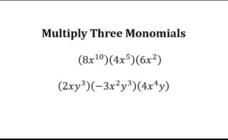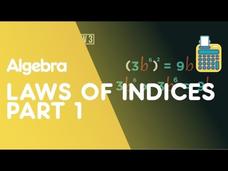Khan Academy
Exponent Properties Involving Products, Numbers and Operations, 8th grade
After a short review of exponents, Sal incorporates exponent properties into his sample problems. This video is a great resource for those who need Sal's steady pace of instruction and the challenge of more complicated problems.
Mathispower4u
Exponent Review (Example 1)
It's easy to become an expert on exponents. Viewers of an educational video first review the properties of exponents. They then see examples covering multiplying and dividing exponents, applying the power property, and rewriting...
Mathispower4u
Exponent Review (Example 2)
Expect to learn a lot about exponents. An instructional video works through examples that show how to apply the properties of exponents when there are two variables, x and y. Scholars learn about the product of powers property, the...
Flipped Math
Rational Exponents
The power of a good lesson is exponential. Young mathematicians view a video lesson that introduces rational exponents and how exponent properties apply. They then use properties of exponents to solve exponential equations with rational...
Mathispower4u
Multiply Three Monomials
Moving from two to three monomials isn't such a huge leap. Scholars watch a short video that shows how to multiply three monomials together. The two examples include one with multiple variables.
Mathispower4u
Multiplying Monomials (Example)
If classmates can multiply and add integers, they're well on their way to mastering multiplication of monomials. Using the resource, future mathematicians learn how to multiply monomials. A short instructional video goes over four such...
Mathispower4u
Multiplying Polynomials
From exponents to monomials to polynomials, it's important to expand your ability to multiply. An instructional video first reviews the rules for multiplying exponents and multiplying monomials. Viewers then learn how to multiply...
Corbett Maths
Laws of Indices
Laws are meant to be followed, and laws of exponents are no exception! A video presentation outlines the laws of exponents and then provides an example of each. After watching the presentation, learners practice with the included resources.
Mathispower4u
Write Repeated Multiplication Using Exponents (Example)
Strengthen your classes' understanding of an exponent before tackling its properties. A quick video lesson reviews the role of an exponent by rewriting expressions with repeated multiplication. Learners watch as the instructor explains...
FuseSchool
Laws of Indices—Part 1
Index the rules of exponents. The British resource presents the laws of exponents for multiplication, division, raising a power to a power, and raising to the power of zero. Explanations demonstrate why the rules work.
Krista King Math
Power Rule with Negative Exponents
Scholars learn how to approach a problem with multiple rules to apply through a video that demonstrates several examples with both integer and variable bases. They explore problems that combine two types of exponent properties.
Krista King Math
Rules of Exponents
Explore all the rules of exponents in one place. As learners watch the video lesson, they see the different types of power expressions and learn how to simplify. The instructor discusses the process and then demonstrates the rule....
Curated OER
What's the Power of a Power Rule?
Follow along and learn a slick trick to help you solve problems involving an exponent raised to another exponent. You'll use the power of a power rule and simplification to solve the problem. This is a clear tutorial that does a good job...












